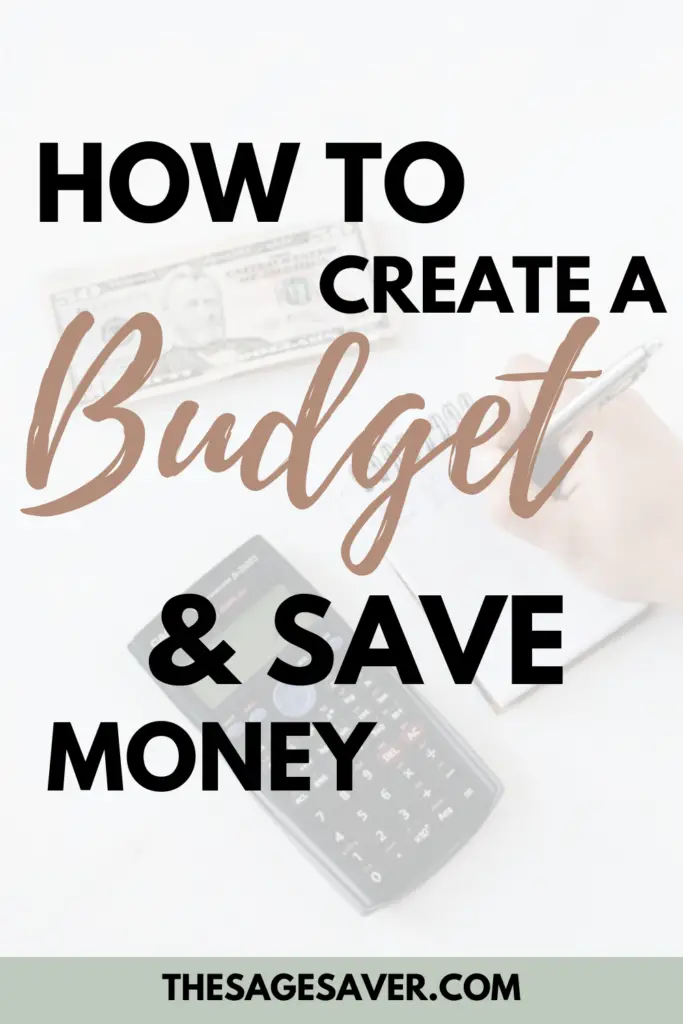How to Create a Budget to Save Money
Most people need some way of seeing where their money is going each month. A budget can help you feel more in control of your finances and make it easier to save money for your goals. I know it can seem overwhelming, but I’m here to help! I’m going to take you step-by-step so you can create a budget to save money.

Why do I need a budget?
Having a budget keeps your spending in check and makes sure that your savings are on track for the future. Budgeting can help set long-term financial goals, keep you from overspending, and allow you to live below your means.
Choose Your Budgeting Method
Some prefer apps, some like spreadsheets. Your girl is a pen and paper gal all day. This is the exact budget sheet I use every single month to budget our expenses. It really doesn’t matter, as long as you have all the important items on your budget and it all evens out, choose any method you prefer.
When to Budget
It’s important to choose when you will budget. It’s popular to budget monthly, but I prefer weekly. I take each bill for each category and divide them by 4. So if my phone bill is $45 a month, I take $45/4=$11.25. I will round up to $12 and deposit that money from my husband’s check into our bill payment account. So every week, $12 goes into the bill pay account and when the bill comes, I pay it right away. It has been the way I can stay on budget the most consistently. When we were paid bi-weekly, I budgeted bi-weekly. Make your budget work for you!
Know Your Income
To create an accurate budget, you must start by calculating your total monthly income. A common mistake I see people make is they include their anticipated overtime or bonuses. Do NOT do this. Those are not a guarantee. Those can be added as extra and thrown towards debt, savings, or any other unexpected expenses you may have.
Add Up Your Fixed Expenses
Next up, make a list of your fixed monthly expenses. Fixed expenses are those that are the same every month. This would include rent or mortgage, insurance, cable and internet, student loan, car payment, etc.
Track Your Money
Once you’ve figured out your income and fixed expenses, you know how much money is left to put toward variable expenses. It’s important to know how much you’re spending or overspending in the variable expenses category.
Go through your bank statements for the past three months with different highlighters and track where your money has gone. I would break your spending up into categories and determine how much you’ve spent monthly in each category. Use your highlighters for each different category. Here are some categories you may want have:
- Utilities
- Transportation (gas, car maintenance)
- Groceries
- Eating Out
- Shopping
- Household Items
- Personal Care
- Entertainment
- Hobbies
- Feel free to add or remove any that don’t apply to you.
Divvy Up Your Paycheck
After you know where your money currently is being spent, it’s time to reassess and make decisions on how much money should be allocated to each budgeting category going forward. Here are the recommended budgeting percentages to get you started. It’s important to choose realistic amounts for each category. Don’t throw all your money into one category you never use over one you use consistently.
Incorporate Sinking Funds
When I say sinking funds revolutionized my budget, I AM NOT KIDDING. I can’t tell you how many times we were strolling along, sticking to our budget, savings was filling up, and BOOM. An event that happens on a regular basis that we didn’t plan or have money set aside for. It would take us back a step. Sinking funds are super important.
You simply choose a set amount for each category and divide it by the number of weeks you are going to be saving up. For instance, we save up $600 for Christmas. We start in January and like to buy our gifts by the end of November. That gives us about 50 weeks to save up. So we take $600/50=$12. So we need to save up $12 for 2024 for Christmas. We will have our gifts purchased well in advance and the money will be there throughout the year if we find something on sale, at a thrift store, or yard sale. See how it works? Isn’t $12 a week better than $600 all at once?
Here are some categories for your sinking funds to get you started:
- Christmas
- Misc Holidays
- Birthdays
- School Supplies
- Quarterly, semi-annually, annual insurance costs
- Home Repairs
- Car Maintenance
- Clothing
- Extracurriculars
- Pet Care
- Add anymore you might need that aren’t a fixed or variable expense!
Stock Your Savings
Having an emergency fund is crucial. If you don’t have any type of savings, you will get stuck in the debt cycle or continue living paycheck to paycheck. Make sure something is going towards savings. Here’s a post I did all about emergency funds.
Decide on a debt-payoff plan
If you have debt, it’s important to pay it off. While it might be tempting just to pay your minimum monthly payments, it will take you a lot longer to pay off that debt, and you’ll be spending a LOT of interest. How you choose to do it is up to you.
There is the debt snowball method coined by Dave Ramsey. You choose your lowest balance of debt that you will pay off first. You make minimum payments on all your other debt payments. All your extra debt payoff money will go toward the debt with the lowest balance. When that is paid off, you move onto the next lowest, and on and on.
There is also the avalanche method. It’s the same principal, but instead of the lowest balance, you choose the one with the highest interest.
They both have their place and whichever you choose is up to you. If you need to see progress fast, the debt snowball will probably work best for you. I prefer using a mix of the two. It all depends on what it is, how long it’s been there, when I want it paid off by, etc. As I said, the choice is yours, but as long as you have a plan, you are on your way to debt freedom.
Reevaluate Your Budget Often
Budgets are not a one and done. As I said, you’ll need to decide how often you budget, but you still very well may look over your budget every few days. It will also need to be reevaluated from time to time to make sure you’re putting enough into your sinking funds, not overspending in your variable expenses, and that your fixed expenses are still the same.
Well, there you have it! A step by step guide for how to create a budget. Do you have a budget? Are there any tips you can give others? Let me know down in the comments.






